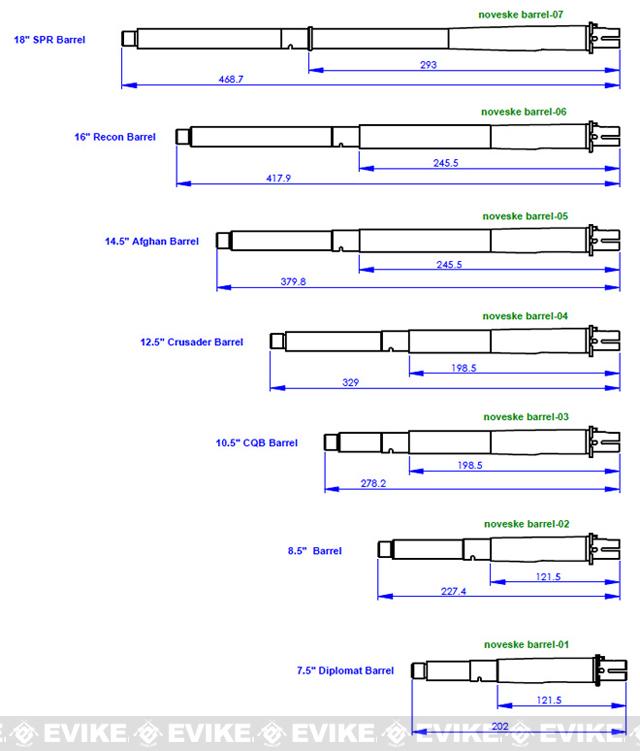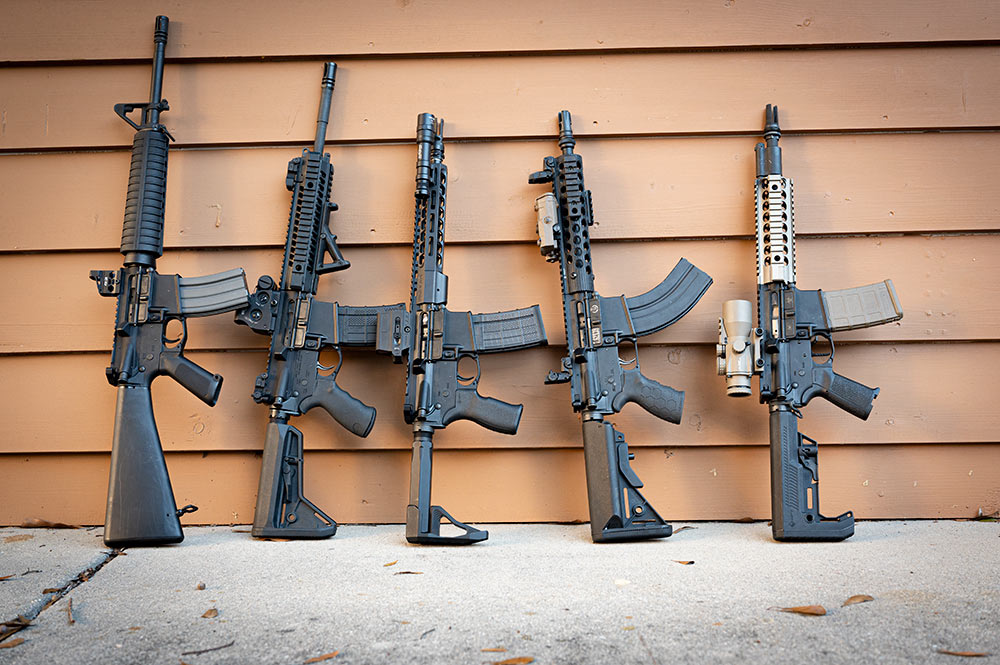M16 Rifle Barrel Length: A Comprehensive Guide
The M16 rifle has been one of the most iconic firearms in military history, and its barrel length plays a crucial role in its performance and versatility. Whether you're a firearms enthusiast, a military historian, or someone interested in the technical aspects of rifles, understanding the M16 rifle barrel length can provide valuable insights into its design and functionality. In this article, we will delve deep into the topic, exploring its significance and applications.
The M16 rifle has undergone numerous iterations since its inception, and one of the most debated aspects is the length of its barrel. The barrel length affects the rifle's accuracy, range, and portability, making it a critical factor for military personnel and civilian users alike. As we proceed, we will explore how different barrel lengths impact the performance of the M16 rifle.
This article is designed to provide a thorough understanding of the M16 rifle barrel length, covering its history, technical specifications, and practical implications. Whether you're looking for technical details or historical context, this guide will serve as a comprehensive resource for all your queries.
Read also:How Tall Is The Actor Who Plays Howard Wolowitz Discover The Facts About Simon Helberg
Table of Contents
- History of the M16 Rifle
- Impact of Barrel Length on Performance
- Common M16 Rifle Barrel Lengths
- Accuracy and Barrel Length
- Portability vs. Performance
- M16 Rifle Barrel Length in Military Usage
- Civilian Use of M16 Rifle Variants
- Ballistics and Barrel Length
- Maintenance Tips for M16 Rifle Barrels
- Conclusion
History of the M16 Rifle
The M16 rifle, developed in the late 1950s by Eugene Stoner, was officially adopted by the U.S. military in the 1960s. It quickly became the standard service rifle for American forces during the Vietnam War. One of the key features of the M16 was its lightweight design, which was achieved through the use of advanced materials and engineering techniques.
From its early days, the M16 underwent several modifications, leading to variants such as the M16A1, M16A2, M16A3, and M16A4. Each variant featured improvements in ergonomics, accuracy, and reliability, but one of the most notable changes was the adjustment of barrel lengths to suit different operational requirements.
Today, the M16 rifle remains a staple in military arsenals around the world, with its design influencing countless other firearms. Understanding its history provides a foundation for comprehending the importance of barrel length in modern firearms.
Impact of Barrel Length on Performance
How Barrel Length Affects Accuracy
The length of the M16 rifle barrel directly impacts its accuracy. Longer barrels generally provide better accuracy due to increased barrel time, allowing the bullet to stabilize before exiting the muzzle. This stabilization is crucial for maintaining consistent trajectory over long distances.
Shorter barrels, on the other hand, are more suitable for close-quarters combat (CQB) scenarios, where maneuverability is prioritized over long-range precision. However, shorter barrels may sacrifice some velocity and accuracy, which can be a disadvantage in certain situations.
Velocity and Barrel Length
Another critical factor influenced by barrel length is bullet velocity. Longer barrels allow for more propellant to burn before the bullet exits the muzzle, resulting in higher muzzle velocities. This increased velocity translates to better penetration and extended effective range.
Read also:Sophia Raiacuten The Rising Star In The Entertainment World
For example, an M16 rifle with a 20-inch barrel typically achieves higher velocities compared to its 14.5-inch counterpart. However, advancements in ammunition technology have mitigated some of these differences, allowing shorter barrels to perform admirably in various scenarios.
Common M16 Rifle Barrel Lengths
The M16 rifle comes in various barrel lengths, each tailored to specific operational needs. Below are some of the most common barrel lengths and their applications:
- 20-inch: Standard barrel length for the original M16, offering optimal accuracy and range.
- 14.5-inch: Common in modern M4 carbines, providing a balance between portability and performance.
- 10.3-inch: Used in compact variants like the Colt Commando, ideal for close-quarters engagements.
- 16-inch: Widely used in civilian AR-15 models, meeting legal requirements while maintaining respectable performance.
Each length has its advantages and disadvantages, making it essential to choose the right barrel length based on intended use.
Accuracy and Barrel Length
Accuracy is one of the most critical factors when selecting an M16 rifle barrel length. Longer barrels typically provide better accuracy due to the increased time the bullet spends stabilizing inside the barrel. This stabilization is achieved through the rifling, which imparts spin to the bullet, improving its aerodynamic performance.
However, advancements in ammunition technology have allowed shorter barrels to achieve impressive accuracy levels, making them suitable for a wide range of applications. Factors such as barrel quality, ammunition type, and shooter skill also play significant roles in determining overall accuracy.
Portability vs. Performance
When choosing an M16 rifle barrel length, one must balance portability with performance. Longer barrels offer superior accuracy and range but can be cumbersome in tight spaces. Shorter barrels, while more portable, may sacrifice some velocity and accuracy.
Military units often opt for shorter barrels for urban combat scenarios, where quick handling and maneuverability are essential. Conversely, long-range shooting enthusiasts may prefer longer barrels for their enhanced precision and range.
M16 Rifle Barrel Length in Military Usage
Adaptation to Modern Warfare
The M16 rifle's barrel length has evolved to meet the demands of modern warfare. In the early days, the standard 20-inch barrel was the norm, but as combat environments changed, shorter barrels became more prevalent.
The M4 carbine, with its 14.5-inch barrel, has become the primary service rifle for many branches of the U.S. military. Its compact design and versatility make it ideal for a wide range of missions, from urban combat to vehicle-based operations.
Special Operations Forces
Special operations forces often utilize even shorter barrels, such as the 10.3-inch variants found in weapons like the Colt Commando. These rifles are designed for extreme close-quarters combat, where speed and agility are paramount.
Despite their shorter barrels, these weapons maintain impressive performance due to advancements in ammunition and barrel technology, ensuring they remain effective in various scenarios.
Civilian Use of M16 Rifle Variants
Civilians interested in owning M16 rifle variants must adhere to legal regulations, which often dictate minimum barrel lengths. In the United States, for example, the minimum barrel length for civilian-owned rifles is typically 16 inches, unless the owner has obtained a special permit.
Many civilian users opt for AR-15 platforms, which are semi-automatic versions of the M16. These rifles are available in various barrel lengths, allowing enthusiasts to choose the configuration that best suits their needs, whether for recreational shooting, hunting, or competitive events.
Ballistics and Barrel Length
Ballistics is the study of how projectiles behave when fired from a weapon, and barrel length plays a significant role in this process. Longer barrels allow for more propellant to burn before the bullet exits the muzzle, resulting in higher muzzle velocities and better downrange performance.
Shorter barrels, while sacrificing some velocity, can still deliver impressive results with modern ammunition. Advances in bullet design and propellant technology have made it possible for shorter barrels to perform admirably in various scenarios, making them a viable option for many users.
Maintenance Tips for M16 Rifle Barrels
Proper maintenance is crucial for ensuring the longevity and performance of an M16 rifle barrel. Below are some tips to help you keep your barrel in optimal condition:
- Regularly clean the barrel to remove carbon buildup and fouling.
- Use high-quality cleaning solvents and brushes specifically designed for firearms.
- Inspect the barrel for signs of wear or damage during routine maintenance.
- Store the rifle in a cool, dry place to prevent rust and corrosion.
By following these maintenance tips, you can extend the life of your M16 rifle barrel and ensure it continues to perform reliably.
Conclusion
The M16 rifle barrel length is a critical factor in determining the weapon's performance, versatility, and effectiveness. Whether you're a military professional, a civilian enthusiast, or simply someone interested in firearms, understanding the impact of barrel length on the M16 rifle can enhance your knowledge and appreciation of this iconic weapon.
We encourage you to explore the various barrel lengths available and consider how they might suit your specific needs. For further reading, check out our other articles on firearms and military history. Don't forget to leave a comment or share this article with fellow enthusiasts!
Data sources: U.S. Military Manuals, Firearms Industry Publications, Ballistics Research Laboratories.

